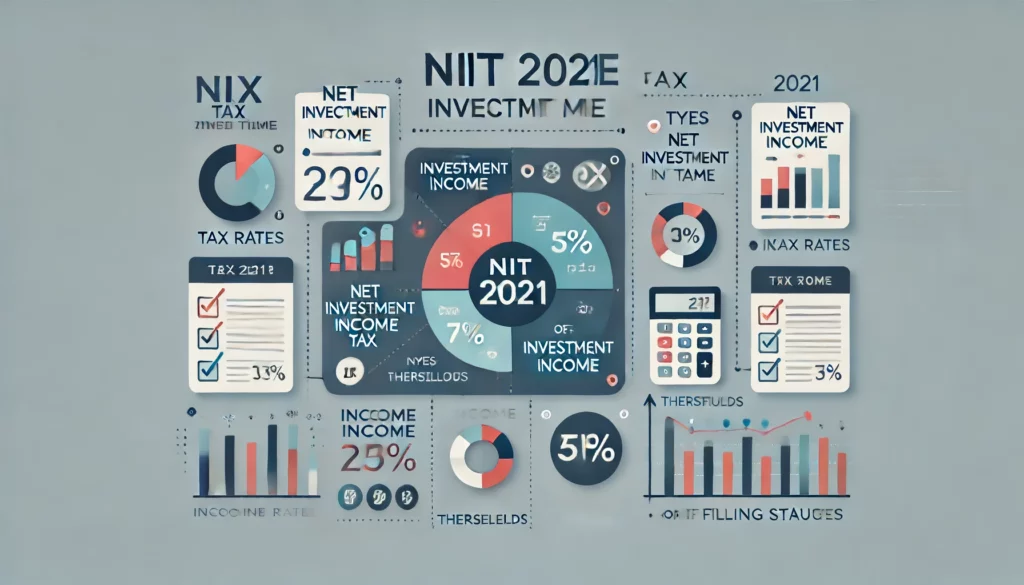In 2021, changes to the tax code brought the Net Investment Income Tax (NIIT) into sharper focus for many taxpayers. Whether you’re new to this tax or looking to brush up on your understanding, we’ve got you covered. This guide will break down what the NIIT is, who it affects, and how you can navigate it effectively. So, let’s dive in to NIIT 2021!
What is NIIT 2021?
Contents
The Net Investment Income Tax (NIIT) 2021 is a 3.8% tax that applies to individuals, estates and trusts with net investment income above certain thresholds. Introduced under the Affordable Care Act, the NIIT is designed to help fund Medicare by taxing high-income earners on their investment income.
Who is Subject to NIIT 2021?
Understanding who is liable for the NIIT 2021 can be a bit complex. Generally, the tax applies to individuals with a modified adjusted gross income (MAGI) exceeding the following thresholds:
- $250,000 for married couples filing jointly
- $125,000 for married couples filing separately
- $200,000 for single filers and heads of household
Trusts and estates are also subject to the NIIT if they have undistributed net investment income and their adjusted gross income exceeds the threshold for the highest tax bracket for estates and trusts.

How is NIIT 2021 Calculated?
To calculate the NIIT 2021, you’ll need to determine your net investment income and your MAGI. Here’s a step-by-step approach:
- Identify Your Net Investment Income: This includes income from interest, dividends, capital gains, rental and royalty income, non-qualified annuities, and income from businesses involved in trading financial instruments or commodities.
- Determine Your MAGI: This is your adjusted gross income (AGI) plus any foreign income exclusions.
- Apply the Thresholds: Compare your MAGI against the relevant threshold (as mentioned above).
- Calculate the NIIT: The NIIT is 3.8% of the lesser of:
- Your net investment income
- The amount by which your MAGI exceeds the threshold
Examples of NIIT 2021 in Action
Let’s look at a couple of scenarios to see how the NIIT 2021 works in real life.
Example 1: Single Filer with High Investment Income
- Jane is a single filer with a MAGI of $250,000 and net investment income of $60,000.
- Her MAGI exceeds the threshold for single filers by $50,000 ($250,000 – $200,000).
- Jane’s NIIT is 3.8% of the lesser of her net investment income ($60,000) or the amount her MAGI exceeds the threshold ($50,000).
- Therefore, Jane’s NIIT is $1,900 (3.8% of $50,000).
Example 2: Married Filing Jointly with Moderate Investment Income
- John and Sarah file jointly with a combined MAGI of $300,000 and net investment income of $40,000.
- Their MAGI exceeds the threshold for married filing jointly by $50,000 ($300,000 – $250,000).
- Their NIIT is 3.8% of the lesser of their net investment income ($40,000) or the amount their MAGI exceeds the threshold ($50,000).
- Therefore, John and Sarah’s NIIT is $1,520 (3.8% of $40,000).
Minimizing Your NIIT 2021 Liability
While the NIIT 2021 might seem unavoidable for some, there are strategies you can employ to reduce your liability:
- Consider Tax-Efficient Investments: Investing in tax-exempt municipal bonds or focusing on growth stocks (which pay less in dividends) can reduce net investment income.
- Utilize Retirement Accounts: Contributions to IRAs and 401(k)s can lower your MAGI.
- Timing Capital Gains: Strategic timing of when you realize capital gains can help manage your income levels in a tax-efficient manner.
- Gift and Estate Planning: Proper planning can help minimize net investment income by moving assets out of taxable estates.
Reporting NIIT 2021 on Your Tax Return
To report the NIIT 2021, you’ll need to fill out Form 8960, “Net Investment Income Tax – Individuals, Estates, and Trusts.” This form helps you calculate your net investment income and any applicable NIIT. Make sure to include this form when filing your taxes to ensure compliance.
Common Misconceptions about NIIT 2021
Let’s clear up some common misconceptions surrounding the NIIT 2021:
- Myth: NIIT Applies to All Income: The NIIT only applies to investment income and only if your MAGI exceeds the threshold.
- Myth: Only the Wealthy Pay NIIT: While the thresholds are relatively high, the tax can affect a broad range of taxpayers, especially those with significant investment income.
- Myth: NIIT Affects All Trusts: Only those trusts with undistributed net investment income and an AGI over the threshold for the highest tax bracket are subject to NIIT.
Planning Ahead for NIIT 2021
If you anticipate being subject to the NIIT 2021, consider discussing your situation with a tax professional. They can help you understand your current exposure and recommend strategies to minimize your liability.
- Regular Reviews: Keeping an eye on your income and investments throughout the year can help you make timely adjustments.
- Tax Diversification: Diversifying your income sources and investments can provide more options for managing your NIIT exposure.
Why Understanding NIIT 2021 Matters
Being aware of the NIIT 2021 and how it affects you is crucial for effective financial planning. It not only impacts your tax bill but also influences decisions about your investments and income strategies. With the right knowledge and planning, you can navigate this tax confidently and keep more of your hard-earned money.
Final Thoughts on NIIT 2021
As you can see, the NIIT 2021 can have significant implications for taxpayers with substantial investment income. By understanding how it works and implementing strategies to manage your liability, you can ensure that this tax doesn’t take an unnecessary bite out of your wealth. Stay informed, plan ahead, and consider professional advice to make the most of your financial situation.

